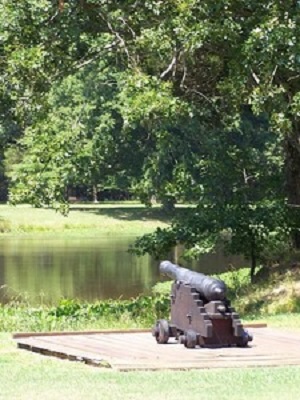
Cannon and musket demonstrations occur regularly at Arkansas Post National Memorial
Established by the French in the late 17th century, Arkansas Post became the first European settlement in the lower Mississippi Valley. In southeastern Arkansas on the north bank of the Arkansas River, Arkansas Post National Memorial commemorates America’s European heritage and preserves the history of a historic post that now lies half underwater. From a trading post and military stronghold to an American town, Arkansas Post was a critical player in the early history of Arkansas and the development of the United States.
Hoping to establish a trading post with the American Indians in the lower Mississippi Valley, Frenchman Henri de Tonti built the first European settlement along the Arkansas River in 1686, and the French settlement began to trade with the Quapaw tribe of Osotouy. The trading post proved unsuccessful, and the French, unable to compete with the British fur trade, abandoned the settlement in 1699. The French reinstated the post as a military garrison in 1720, after King Louis XIV granted land along the river to Scotsman John Law and a group of German settlers. The new inhabitants of the trading post were unable to survive, and John Law’s plans to develop an agricultural colony ultimately failed.
Although settlers sporadically took over the post as time passed, the French did not officially establish another post in the Mississippi Valley until the late 1740s, when the French-Chickasaw war and constant flooding encouraged the settlers to move the post to a better location. In 1751, French Commandant Pelletier de La Houssaye built the new post further up the river near the Quapaw village and away from the Chickasaw to avoid further conflict. Realizing the post’s significance for the defense of French claims in the Mississippi Valley during the Seven Years War, Captain Charles Marie de Reggio moved the post further down the Mississippi River to protect French fleets. When the French and Indian War ended in 1763, the defeated French ceded Louisiana to Spain, and by 1765, the Spanish took control of Arkansas Post.
Spain moved the post back to the location of the original French settlement of 1687 to avoid flooding in 1779, renamed the post Fort Carlos III, and used it as a base to develop a successful fur trade with the Quapaw Indians. The trade allowed the Spanish to gain valuable military allies, which proved useful during the American Revolution when British Captain James Colbert led an attack against the Spanish fort in 1783 with the help of the Chickasaw Indians. The British and Chickasaw Indians were unable to defeat the Spanish-Quapaw counterattack and Colbert eventually retreated. Following the British invasion, the Spanish post never faced another attack or engaged in battle. In the early 1800s, Spain returned Louisiana to France.
Following the Louisiana Purchase of 1803, the United States gained control of Arkansas Post and soon began to transform the European garrison and trading post into an American frontier community. Initially, the United States attempted to maintain a trading empire in the Mississippi Valley by converting Arkansas Post into a government trading center, but the American government was unsuccessful in competing with private trading companies. By 1810, American families began to populate the Mississippi Valley, and in 1819, Arkansas Post became the capital of the Arkansas Territory. Within three years, the town began publishing its first newspaper, the Arkansas Gazette, which brought greater interest in the territory. In 1821, Little Rock became the capital of the Arkansas Territory, which caused the economy and population of Arkansas Post to decline.
By the 1830s, Arkansas Post had gained new significance, this time for cotton production in the area and its location as a major river port; however, in 1844 the town declined again after Arkansas Post lost its position as a county seat. General Thomas J. Churchill recognized the town’s importance for the defense of Little Rock, and in 1862, the Confederate army erected Fort Hindman at Arkansas Post. Although the fort was in a strategic location along the Arkansas River, its earthen structure could not withstand the force of the Union army’s gunboat attack on January 10, 1863. At the conclusion of the Civil War, the town was unable to recover from the shelling, and as increased railroad usage led to a decline in river traffic, Arkansas Post eventually faded away.
Since 1912, only half of Arkansas Post has been visible because of erosion and changes in the course of the Arkansas River that have left its historic resources underground and underwater. Arkansas Post National Memorial today has a park-like appearance with an overlook where visitors can view the Arkansas River. In 1964, when Arkansas Post became a national memorial, the National Park Service began to restore the visible remains at the site to their original 18th century appearance. The park preserves reminders of the history of America’s European heritage and restored segments of the 19th-century town, so visitors can experience the overall history of Arkansas Post's transition from a European trading and military post to an American community.
Today, visitors can walk along trails, stop at wayside exhibits, participate in activities, attend the historic weapons demonstration, and watch interpretive films at the visitor center and museum.
Arkansas Post National Memorial, a unit of the National Park System and a National Historic Landmark, is located at 1741 Old Post Road in Gillett, AR. Click here for the National Park Service’s National Register of Historic Places file: text and photos. The park grounds are open during daylight hours. The visitor center opens daily from 8:00am to 5:00pm, and is closed on Thanksgiving, Christmas, and New Year’s Day. Admission is free. Group tours should make reservations a week in advance. For more information, visit the National Park Service Arkansas Post National Memorial website or call 870-548-2207.
Last updated: August 4, 2017
